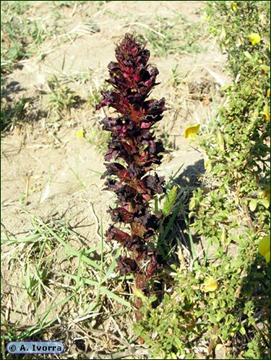CGKB News and events Management strategies
Weeds - chickpea
Contributors to this page: ICRISAT, India (RP Thakur, AG Girish, VP Rao); ICARDA, Syria (Siham Asaad, Abdulrahman Moukahal).
|
Contents: |
Scientific names
Orobanche foetida Pers.
Orobanche crenata Forsk.
Orobanche ramosa L.
Significance
Yield reductions of 30 to 70% are not uncommon. International markets may reject broomrape-contaminated produce.
Symptoms
The appearance of the parasite itself is the clearest sign of infestation. The parasite has erect, branched or unbranched aerial flowering shoots. The leaves are reduced to scales and are disposed alternatively. The shoots bear bisexual tubular flowers in a spike. The tiny seeds are produced in enormous numbers in capsules.
Hosts
Broomrapes usually only parasitic to broadleaved plants but there are a few records of attacks on monocots (grasses, etc.). Branched Broomrape attacks many crops and common weeds. Non-host crops can support infestations because of their weed component, and the produce of such crops may carry Broomrape seeds. Some Broomrape species have specialized biotypes or races. Plants of the same species attack different sets of hosts in different geographic areas. Susceptibility to attack also depends on the cultivar or genetic characteristics of a particular crop. The plants attacked by Branched Broomrape around the world include:
Crops: bean, broad bean, cabbage, capsicum (peppers), canola, carrot, cauliflower, celery, chickpea, clovers, eggplant (aubergine), flax, hemp (cannabis), hops, lentil, medicagos, onion, parsnip, paprika, pea, pyrethrum, sunflower, tobacco, tomato and potato.
Geographic distribution
Western and Central Asia (especially in Afghanistan, Syria, Egypt, India, Iran, Jordan, Lebanon, Morocco, Pakistan, Saudi Arabia, Australia, Europe (especially the Mediterranean), N. africa and N. america.
Biology and transmission
Seeds germinate in moist soil at 18 to 23°C and require moist soil for one week to become established. The roots parasite the roots of host plants for 40 to 50 days. Stems emerge in spring and are visible for only about three weeks from the end of September through to October. Flowering is rapid, within 6 to 9 days after stem emergence, with a similar period between the cessation of flowering and the ripening of fruit. An infestation may contain many plants that do not produce above-ground parts.
Dispersal from property to property and within properties in the infested area in South Australia appears to be mainly by carriage on vehicles and machinery. Seeds stick to equipment and animals that contact the plant and can also be dispersed by wind and water (including irrigation water/sprinklers), in animal manure, soil, fodder, on livestock and on footwear and clothing. Seeds attach to crop seeds and other produce. Seedlings imported from infested areas can carry seeds stuck to their leaves or in the soil. Seeds remain viable after passage through the digestive tracts of animals including cattle and goats.
Detection/indexing method in place at the CGIAR Centres
- At ICARDA - Filter Wash Test.
- At ICRISAT - Not applicable.
Treatment/control
Hand weed shoots prior to their seed formation to reduce inoculum levels. This is recommended in minor infestations only.
- Sow the crop late to help plants escape the worst effects of infection.
- Plow deep to bury Orobanche seeds into deeper soil layers to reduce infestation.
- Use selective herbicides such as imazaquin (10-15 ml a.i./ha).
- Use soil solarization to reduce soil-borne inoculum.
- Use resistant varieties, if available.
Procedure followed at the CGIAR Centres in case of positive test
- At ICARDA - Mechanical rotation, herbicides.
- At ICRISAT - Not applicable.
References and further reading
http://www.agroatlas.ru/en/content/weeds/Orobanche_ramosa/
|
Orobanche foetida (photo: ICARDA) |
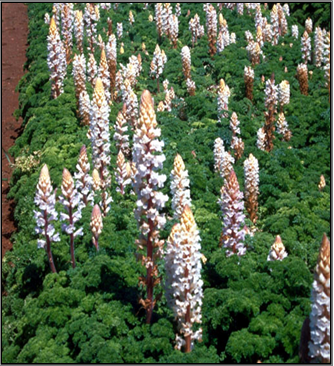
Orobanche crenata (photo: ICARDA) |

Orobanche ramosa (photo: ICARDA) |
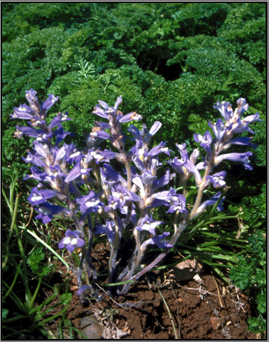
Orobanche egyptiaca (photo: ICARDA) |
Scientific name
Cuscuta hyalina Roth.
Other scienfiic name
Cuscuta pentagona.
Significance
The effect of field dodder on 12 legume crops was investigated in a greenhouse experiment. The legume crops showed great variations in response to field dodder parasitism. Based on the reduction in host dry weight (biological yield) caused by the parasite, chickpea lost >50% of its biological yield and was considered highly susceptible.
Symptoms
The appearance of the parasite itself is the best diagnostic symptom. It has fine, yellow or orange, thread-like branches which grow and entwine around the stems and other aboveground parts of the host.
Dodder-infected areas appear as patches in the field and continue to enlarge during the growing season. In late spring and early summer, dodder produces a massed cluster of white flowers.
Infected host plants become weakened, decline in vigour and produce poor yields.
Several patches might coalesce to form large areas that can be easily recognized by the yellowish colour of the parasite strands.
Hosts
Cuscuta species attack a wide range of species including vegetables, fruits, ornamentals and woody plants. It is reported as a weed in 25 crops in 55 countries.
Geographic Distribution
Cosmopolitan.
Detection/indexing method in place at the CGIAR Centres
- At ICARDA - Filter Wash Test.
- At ICRISAT - Not applicable.
Treatment/control
- Cultural Practices: Dodder is best controlled through prevention by using clean seed. Ornamental beds should be kept clean of seed-producing plants. Once dodder becomes established, eradication is almost impossible. Mechanical removal can be attempted, but once dodder has produced the haustoria it is almost impossible to avoid damage to the host plant. If dodder has germinated and has attached to a host plant, removal of both is recommended to eradicate.
- Herbicide Use: use of pre-emergent herbicides is the best chemical approach. These products must be applied prior to the germination of the seed as the small seedling root will drop off once the haustoria has formed. Dinitroanaline herbicides have been reported to be effective. Dichlobenil has also shown good results. Read all labels to ensure that the herbicides can be used around the host plants. Glyphosate has shown results as a postemergent herbicide, but its use is limited as it will also damage the host plant. Phenoxy herbicides have only shown limited control and again, injury to the host plant can occur.
Procedure followed at the CGIAR Centres in case of positive test
- At ICARDA - Mechanical control, cultural practices and herbicides.
- At ICRISAT - Not applicable.
References and further reading
http://www.icarda.org/Publications/Field_Guides/Lentil/Lentil.htm#Lent7.Html
http://www.weedalert.com/weed_pages/wa_dodder.htm
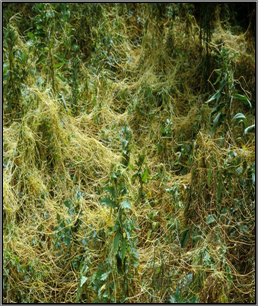
Cuscuta hyalina (photo: ICARDA) |
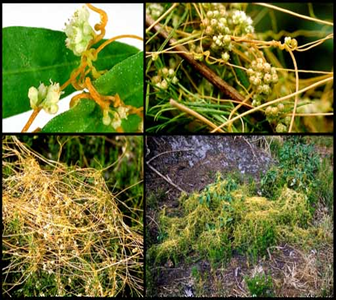
Cuscuta campestris (photo: ICARDA) |
Safe transfer of millets germplasm
Contributors to this page: ICRISAT, Patancheru, India (RP Thakur, AG Girish, VP Rao).
The Plant Quarantine Laboratory (This email address is being protected from spambots. You need JavaScript enabled to view it.) at ICRISAT, Patancheru, India caters to the plant quarantine requirements of the ICRISAT scientific community with respect to the germplasm exchange of ICRISAT’s mandate crops: sorghum [Sorghum bicolor (L.) Moench)], pearl millet [Pennisetum glaucum (L.) R. Br.], chickpea [Cicer arietinum (L.)], pigeonpea [Cajanus cajan (L.) Millspaugh], groundnut [Arachis hypogaea (L.)] and six small millets: finger millet [Eleusine coracana (L.) Gaertn.], foxtail millet [Setaria italica (L.) Beauv.], little millet (Panicum sumatrense Roth.ex Roem. & Schult.), barnyard millet [Echinochloa crussgalli (L.) Beauv.], proso millet [Panicum miliaceum (L.)] and kodo millet [Paspalum scrobiculatum (L.)].
Indian plant quarantine regulations are legislated under the Destructive Insects and Pests Act, 1914 and the Plant Quarantine Order 2003 for the purpose of prohibiting and regulating the import of agricultural articles into India.
- Seed and plant material of these crops cannot be exported/ imported directly by the institute’s scientists.
- The National Bureau of Plant Genetic Resources (NBPGR) of the Indian Council of Agricultural Research (ICAR), New Delhi, is the plant quarantine authority responsible for ICRISAT’s germplasm exchange.
In 1985, NBPGR established a Regional Station at Rajendranagar, Hyderabad to implement the quarantine regulations in South India, to ensure safe movement of germplasm.
This page includes sections on:
- Import and export requirements.
- Technical guidelines for the safe movement of germplasm and detection of relevant pathogens and pests.
- Best practices in place at ICRISAT.
References and further reading
Ahmed KM, Ravinder Reddy Ch.1993. A Pictorial guide to the identification of seed borne fungi of sorghum, pearl millet, finger millet, chickpea, pigeonpea and groundnut. Information Bulletin No. 34. Patancheru, A.P. 502 324 India: International Crops Research Institute for the semi-Arid Tropics. 200 pp.
Chakrabarty SK, Anitha K, Girish AG, Sarath Babu B, Prasada Rao RDVJ, Varaprasad KS, Khetarpal RK, Thakur RP. 2005. Germplasm exchange and quarantine of ICRISAT mandate crops. Information Bulletin No. 69. Rajendranagar 500 030, Andhra Pradesh, India: National Bureau of Plant Genetic Resources; and Patancheru 502 324, Andhra Pradesh, India: International Crops Research Institute for the Semi Arid Tropics. 80pp.
Import/export of millets germplasm
Contributors to this page: ICRISAT, Patancheru, India (RP Thakur, AG Girish, VP Rao).
Exporting germplasm
The ICRISAT-PQL, in conjunction with NBPGR Regional Station, Hyderabad, conducts seed health tests on germplasm prior to export. The following export guidelines are to be followed before submitting seed material This email address is being protected from spambots. You need JavaScript enabled to view it. for export.
Guidelines
- Pre-export inspection of seed multiplication fields by NBPGR quarantine officials for seedborne diseases at various growth stages of the crop to avoid their spread.
- Collection of seed from fully mature and healthy plants.
- Cleaning seed to remove insects, pathogen propagules (smut sori, ergot sclerotia, and nematode cysts), weed seed, crop debris, soil clods, stones, other foreign material, and small, shrunken, discolored and damaged seed.
- Submission of an on-line request for export of germplasm (form available at ICRISAT intranet under GT-Crop Improvement).
- Submission of untreated seed in fresh muslin bags or paper packets along with the four-point declaration certificate (available at This email address is being protected from spambots. You need JavaScript enabled to view it.) for quarantine processing.
- Submission of the importing country’s plant photosanitary requirements, such as import permit, non-commercial value certificate, additional declaration for seed borne pathogens and pests, and any other specific regulations/requirements for millets are shown below:
Examples of seed export letters are given below:
- Seed export letter - air mail
- Seed export letter - courier
For more detailed information see the full text of the Plant Quarantine Guidelines and Procedures for Germplasm Exchange of ICRISAT Mandate Crops (ICRISAT, 2004).
Importing germplasm
Seed and plant material for research can only be imported into India after obtaining an Import Permit (IP). As per Schedule X of the Plant Quarantine Order, 2003, Director, NBPGR is empowered to issue import permits for all kinds of import of plant germplasm for public/private sector institutions in the country. An IP is also required to import live insects, all fungi in pure cultures, soil, or clay for microbiological studies or physical and chemical analyses. For each of these items, authorities designated by the Government of India issue the import permit. The consignee should abide by the following import guidelines.
Guidelines
- Submission of on-line request for import (form available at ICRISAT intranet under GT-Crop Improvement) of seed/plant/plant products/ other material) to This email address is being protected from spambots. You need JavaScript enabled to view it..
- Submission of the import application by This email address is being protected from spambots. You need JavaScript enabled to view it. to the relevant import-issuing authority (see table below).
Competent authorities to issue various import permits
|
Type of imports |
Permit issuing authority |
|
Seeds and plants for sowing, |
Director, National Bureau of Plant Genetic Resources (NBPGR) Pusa Complex, New Delhi 110 012.
|
|
Live insects |
Plant Protection Adviser to the Government of India, Directorate of Plant Protection Quarantine and Storage N.H. IV, Faridabad, Haryana 121 001, India
|
* After getting clearance from the Department of Biotechnology (DBT),
Block 2, 7th floor, C.G.O. Complex, Lodi Road, New Delhi 110030
- This email address is being protected from spambots. You need JavaScript enabled to view it. provides the import permit to the consignee along with mailing labels, guidelines, and an advance notice form for onward transfer to the consignor.
- Advance notification of shipment by the consignor to the Director, NBPGR, New Delhi 110012, India with a copy to the Chief Plant Quarantine Officer, ICRISAT.
- (The consignor should use green-mailing labels bearing the address “Director, NBPGR, New Delhi 110 012”).
- Accompanied baggage import: Seed and plant material brought as accompanied baggage also requires an IP and PC. The international airports located at New Delhi, Chennai, Mumbai, and Kolkata are the points of entry for seed/plant samples brought into India as accompanied baggage. In such cases the seed samples should be handed over to the staff of the Plant Quarantine and Fumigation stations at the airport.
For more detailed information see the full text of the Plant Quarantine Guidelines and Procedures for Germplasm Exchange of ICRISAT Mandate Crops (ICRISAT, 2004).
References and further reading
International Crops Research Institute for the Semi-Arid Tropics (ICRISAT). 2004. Plant Quarantine Guidelines and Procedures for Germplasm Exchange of ICRISAT Mandate Crops. Indian Council of Agricultural Research, India; National Bureau of Plant Genetic Resources, India; International Crops Research Institute for the Semi-Arid Tropics, India.
Guidelines (millets)
Contributors to this page: ICRISAT, Patancheru, India (RP Thakur, AG Girish, VP Rao).
Technical Guidelines for the Safe Transfer of Germplasm and the
Protection of CGIAR Germplasm Banks
Pathogens of quarantine significance of millets tested by the Germplasm Health Laboratory of ICRISAT
Finger millet [Eleusine coracana L.]
|
Bacteria
|
|
Pseudomonas syringae pv. syringae.
|
|
Xanthomonas vasicola pv. holcicola
|
|
Xanthomonas campestris (Pammel) Dowson
|
|
Fungi
|
|
Cochliobolus lunatus
|
|
Insects
|
|
Plodia interpunctella
|
|
Prostephanus truncates
|
|
Tribolium castaneum
|
Pearl millet [Pennisetum glaucum (L.) R. Br.]
|
Bacteria |
|
Pseudomonas syringae pv. syringae van Hall. |
|
Xanthomonas campestris (Pammel) Dowson |
|
Xanthomonas vasicola pv. holcicola (Elliott). |
|
Fungi |
|
Bipolaris setariae (Saw.) Shoem. |
|
Claviceps fusiformis Loveless |
|
Moesziomyces penicillariae (Bref.) Vanky. |
|
Pyricularia grisea (Cke.) Sacc. |
|
Sclerospora graminicola (Sacc.) Schroet. |
|
Insects |
|
Plodia interpunctella Hubner. |
|
Prostephanus truncatus Horn. |
|
Sitotroga cerealella Olivier |
|
Tribolium castaneum Herbst. |
More Articles...
- Bacteria - finger millet
- Fungi - finger millet
- Insects - finger millet
- Best practices for the safe transfer of millet germplasm
- Guidelines for the safe transfer of pearl millet germplasm
- Guidelines for the safe transfer of finger millet germplasm
- Insects - pearl millet
- Fungi - pearl millet
- Bacteria - pearl millet
- Safe transfer of barley germplasm
Subcategories
-
main
- Article Count:
- 11
-
Stog
- Article Count:
- 2
-
Stog-rice
- Article Count:
- 7
-
Stog-sorghum
- Article Count:
- 11
-
Stog-common-bean
- Article Count:
- 10
-
stog-forage-legume
- Article Count:
- 10
-
stog-forage-grass
- Article Count:
- 11
-
stog-maize
- Article Count:
- 9
-
stog-chickpea
- Article Count:
- 10
-
stog-millets
- Article Count:
- 12
-
stog-barley
- Article Count:
- 10
-
stog-groundnut
- Article Count:
- 9
-
stog-pigeon-pea
- Article Count:
- 8
-
stog-wheat
- Article Count:
- 10
-
stog-lentil
- Article Count:
- 9
-
stog-cowpea
- Article Count:
- 10
-
stog-faba-bean
- Article Count:
- 9
-
risk management
- Article Count:
- 4
-
decision support tool
- Article Count:
- 3
-
stog-clonal
- Article Count:
- 23
-
developing strategies
- Article Count:
- 4





